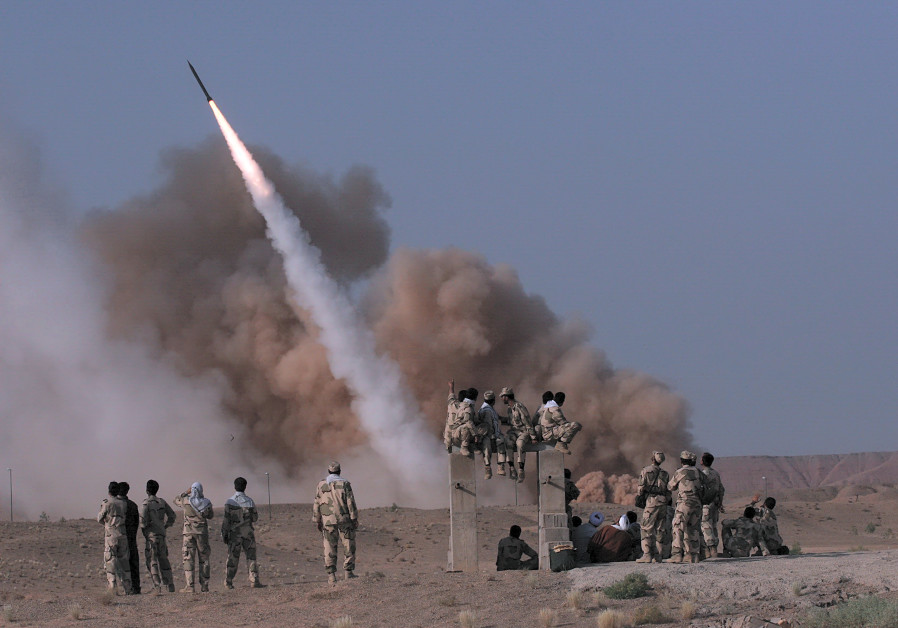Israeli embassies on alert, air defenses adjusted in face of Iran threat

Members of Iran’s revolutionary guard look at a surface to surface missile which is launched during a war game near the city of Qom, about 120 km (75 miles) south of Tehran June 28, 2011. (photo credit: RAUF MOHSENI/MEHR NEWS AGENCY/REUTERS)
Israel’s Air Force has adjusted its air defenses, and several Israeli embassies around the world have raised their alert level in light of increased tensions from Iran.
According to reports in Hebrew-language media, a series of adjustments were made to IAF air defense systems in light of the fear that Iran might try to carry out an attack using cruise missiles or suicide drones similar to the October attack against Saudi Arabia.
IDF Chief of Staff Lt.-Gen. Aviv Kochavi and Prime Minister Benjamin Netanyahu have warned in recent days of the increased threat posed by the Islamic Republic, which they say is getting bolder and more willing to respond to Israeli attacks on Iranian and Iranian-backed militias and infrastructure.
“Iran wants to develop precision-guided missiles that can hit any target in Israel within 5-10 meters: It’s doing it,” Netanyahu said Monday evening during an event at the Jewish Agency. “Iran wants to use Iraq, Syria, Lebanon and Yemen as bases to attack Israel with statistical missiles and precision-guided missiles. That is a great, great danger.”
At the event, United States Treasury Secretary Steven Mnuchin added that the US is planning more sanctions to place on Iran in its “maximum pressure campaign.”
While Iran has several rockets which could reach Israeli territory, including the Khoramshahr 2 with a range of up to 2,000 kilometers, it is unclear if they transferred such missiles to Yemen.
According to a report in the online magazine Breaking Defense, Israel has recently upgraded the Barak-8ER system with an extended range to protect against cruise missiles, a land-based configuration of the long-range surface-to-air missile (LRSAM) or the Barak-8 naval air defense system.
Boaz Levy, Israel Aerospace Industries VP and general manager, was quoted in the report as saying that the upgraded version of the Barak-8ER system has enhanced anti-tactical ballistic missile capabilities and will be capable of protecting Israeli cities from cruise missiles.
Able to shoot down enemy aircraft at a range of 90 kilometers, the Barak-8ER is designed to defend against a myriad of short- to long-range airborne threats such as incoming missiles, planes and drones at both low or high altitudes. In July, the Israeli military successfully tested the Barak 8, intercepting a small drone simulating an enemy aircraft.
The system integrates several advanced state-of-the-art systems including a digital radar, a command and control system, tracking radar launchers, interceptors with advanced homing radio frequency (RF) seekers for targets with low radar cross sections and high maneuverability, data link and system-wide connectivity. It is also able to engage multiple targets simultaneously in severe saturation scenarios and can be operated in all types of weather.
In addition to the Barak-8ER, Israel has a comprehensive, protective umbrella able to counter the growing missile threats from its enemies, which includes the Iron Dome designed to shoot down short-range rockets; the Arrow (Arrow-2 and Arrow-3) system which intercepts ballistic missiles outside of the Earth’s atmosphere; and the newly operational David’s Sling missile defense system which is designed to intercept tactical ballistic missiles, medium- to long-range rockets, and cruise missiles fired at a range of between 40 km. to 300 km.
Israel continuously improves the technology behind the country’s anti-missile systems; all systems have gone through upgrades over the past few years.
Israel also has three Patriot system batteries and has used them against suspicious aerial vehicles, including shooting down drones and a Syrian Sukhoi fighter jet that infiltrated into Israel’s northern Golan Heights last year.
Tzvi Joffre contributed to this report.
`; document.getElementById(“linkPremium”).innerHTML = cont; (function (v, i){ });





Comments are closed.